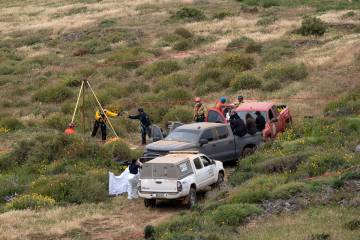US moves to help recovery for Mexican wolves in Southwest
ALBUQUERQUE, N.M. — After decades of legal challenges and political battles that have pitted states against the federal government, U.S. wildlife managers on Wednesday finally adopted a plan to guide the recovery of a wolf that once roamed parts of the American Southwest and northern Mexico.
The plan sets a goal of having an average of 320 Mexican gray wolves in the wild over an eight-year period before the predator can shed its status as an endangered species. In each of the last three years, the population would have to exceed the average to ensure the species doesn’t backslide.
Officials estimate recovery could take another two decades and nearly $180 million, a cost borne largely by breeding facilities that support threatened and endangered species work.
The U.S. Fish and Wildlife Service considered tens of thousands of public comments — from state lawmakers and business groups to independent scientists and environmentalists — as it worked to meet a court-ordered deadline to craft the recovery plan. It was a long time coming as the original guidance for restoring the wolf was adopted in 1982.
“This plan really provides us a roadmap for where we need to go to get this species recovered and delisted and get its management turned back over to the states and tribes,” Sherry Barrett, the Mexican wolf recovery coordinator, told The Associated Press in an interview.
Environmental groups criticize plan
The release triggered immediate criticism from the environmental groups that initially sued to force the agency to craft a new plan. On Wednesday afternoon, they sent the agency a notice of their intent to sue, citing violations of the Endangered Species Act.
Barrett said state wildlife officials and other peers reviewed the scientific data and the models used to calculate the best way forward for the agency as it works to bolster genetic diversity and continue building the wild population.
There are now more of the wolves roaming the Southwest than at any time since the federal government began trying to reintroduce the animals in 1998. The most recent annual survey shows at least 113 wolves spread between southwestern New Mexico and southeast Arizona.
There are about 31 wolves in the wild in Mexico, officials said.
Under the recovery plan, those numbers would be expected to grow to 145 in the U.S. and 100 in Mexico over the next five years.
Barrett said targeted releases of captive-bred wolves and translocations are necessary to make the program work. Improvements in the survival rate — currently 28 percent — will be a factor that affects how many releases are needed, she said.
Management challenges
In an effort to avoid future skirmishes with states, the plan calls for cooperation with wildlife officials in New Mexico and Arizona when it comes to the timing, location and circumstances of the releases. However, federal officials will make the final decisions.
Environmentalists have suggested there needs to be more than 700 wolves in the wild if the population is to withstand illegal shootings, genetic issues and other challenges.
“The final recovery plan fails to recover the Mexican gray wolf. It is political in nature, not science-based,” said Bryan Bird with Defenders of Wildlife, arguing that suitable habitat in the Grand Canyon and Southern Rockies is being ignored.
Environmentalists have pressed for years for more captive wolves to be released, but ranchers and elected leaders in rural communities have pushed back because the predators sometimes attack domestic livestock and wild game.
Last year, the U.S. Interior Department’s internal watchdog said the Fish and Wildlife Service had not fulfilled its obligation to remove Mexican gray wolves that preyed on pets and cattle.
Barrett said with the new plan and other rules that give the agency flexibility in managing problem wolves, there is optimism among officials that progress can be made.
“I know that with most things having to do with wolves, there’s going to be a lot of strong opinions on both sides,” she said. “But to us, it is a big step forward for us to have something in place to start working toward and working with the public to achieve.”
Related
Oregon witnesses return of wolves, but not without conflict





























